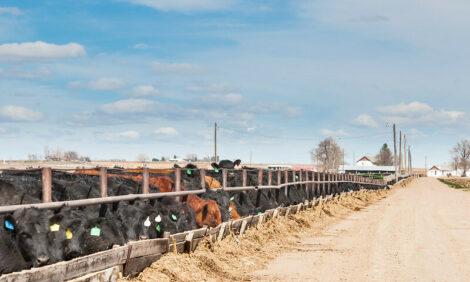



IBR Vaccination Recommended on Kintyre Monitor Farm
SCOTLAND, UK - Herd health issues, in particular Infectious Bovine Rhinotracheitis (IBR), were discussed at the recent meeting of the Quality Meat Scotland (QMS) Kintyre Monitor Farm, held at Glenbarr Farms on the west coast of the Kintyre Peninsula.The monitor farmer Duncan Macalister runs a breeding herd of just over 150 predominantly spring-calving females. This mostly out-wintered herd has a high percentage of Aberdeen-Angus blood. All progeny, other than replacement heifers, are finished.
Earlier this year a number of females which had scanned in calf, failed to produce a calf. This prompted Mr Macalister to ask his vet, Catriona Wilson of the Westwards Veterinary Practice in Campbeltown, to conduct blood tests in the hope of establishing the cause.
Miss Wilson told the community group that in June she had tested ten heifers. Trace element levels had been satisfactory and all had proved negative for Leptospirosis and Bovine Viral Diarrhoea (BVD).
“However, all animals screened showed exposure to the IBR virus and with evidence that this highly infectious virus is circulating in the herd, a disease outbreak in the future is possible,” she said.
Additionally, in late March a female had aborted and consequent blood tests revealed evidence of exposure to the IBR virus.
“So it seems that IBR may have been the cause of the empty, but previously scanned in-calf, cows,” said Miss Wilson.
“However, it’s important to bear in mind that, other than the cow which had aborted in March, neither Mr Macalister nor his staff had seen any of the empty cows aborting and had not found any aborted material where the cows had been kept prior to calving.
“Once a cattle beast is infected it becomes an incurable, lifetime carrier. And while an infected animal does not constantly shed the virus, the virus lodges in nerve cells in its brain and can be triggered by stress, for example transport, adverse weather conditions or calving.”
The IBR virus is spread in discharge from the nose and/or eyes and semen, with housed cattle in poorly ventilated buildings, particularly vulnerable.
The virus impacts on the performance of all age groups of cattle. “In young calves and growing cattle, IBR damages the respiratory tract, allowing in secondary bacterial infections of the lungs, which may prove fatal,” explained Miss Wilson.
“In breeding cattle IBR can cause similar respiratory signs, but can also cause abortion, usually in the second half of the pregnancy.”
Having established a possible cause of the lost calves, the challenge for Mr Macalister, is how to reduce the shedding of the IBR virus and prevent more abortions.
Miss Wilson recommended vaccination using “marker” vaccines, which make it possible to differentiate between natural and vaccination titres in later blood tests.
“There are two forms of IBR vaccines - live and inactivated,” she told the group. “The live vaccine reduces abortion rates and is the better choice to tackle an outbreak. Whereas the inactivated form is better at reducing shedding in carrier animals and can be used to prevent abortions.
“Breeding bulls should only be vaccinated with inactivated vaccine and should not come in contact with stock which have been recently vaccinated with the live vaccine.”
The cost of the live vaccine is approximately £3.00 per dose, (20 doses per bottle), with the inactivated vaccine costing around 15% more.
Mr Macalister plans to vaccinate the herd and introduce an on-going IBR vaccination programme, to reduce the risk of abortions and respiratory infection in calves. This would also hopefully improve the overall performance of his growing cattle which are housed after weaning.
TheCattleSite News Desk


